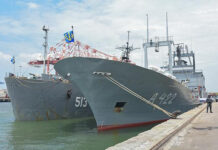The South Korean military apologized for failing to shoot down any of the five North Korean drones that flew on Monday for hours over Incheon, Gyeonggi and parts of Seoul.
“We are sorry about the lack of military preparedness,” Joint Chiefs of Staff (JCS) Director of Operations Kang Shin-chul said Tuesday.
Of the five unmanned aerial vehicles (UAV) that entered South Korean airspace on Monday morning, one entered northern Seoul via Paju and returned across the border after three hours. The other four were detected flying over Ganghwa Island, Incheon, and Gimpo in northern Gyeonggi before vanishing from South Korean radar.
A total of 20 warplanes, including F-15Ks, KF-16s and KA-1 light attack aircraft, were deployed to intercept and shoot down the UAVs.
According to JCS Director of Public Affairs Col. Lee Seong-jun on Tuesday, “the situation yesterday was one where detection and identification happened continuously.”
“Better defensive systems are deployed near important facilities,” he added, ruling out the possibility that any of the drones could have approached the presidential office, which is located in Yongsan, without being detected.
“No drone entered Yongsan airspace,” he noted.
He explained the drones could not be fired upon over populated areas and that they were so small they would disappear from radar at times. Lee said that the military is limited in its ability to identify UAVs under three meters (9.8 feet) in length, and that all of the North Korean drones were estimated to have been under two meters in length.

President Yoon Suk-yeol has blamed the country’s military for lax defensive preparations after it failed to intercept the North’s UAVs and also said that budget cuts may have been to blame.
Flight departures from Incheon International Airport and Gimpo International Airport, both located near Ganghwa Island, were temporarily suspended by aviation authorities at the request of the JCS. It is the first time ever that civilian flights in Korea have been disrupted due to a South Korean military operation.
The South Korean military scrambled Air Force fighters, attack helicopters and other aircraft in an effort to intercept the drones. One of the planes deployed, a KA-1 light attack aircraft, crashed in Hoengseong County in Gangwon at 11:39 a.m.
The South dispatched manned and unmanned assets to the border areas, with some entering the North, the first time drones from the South have crossed the line and the flight has been publicly acknowledged. They surveilled “key enemy military facilities” and conducted other reconnaissance operations, according to the JCS on Monday.
Speaking at the last Cabinet meeting of the year at the presidential office on Tuesday, Yoon said that the drone incursion “demonstrated that our military lacked preparedness and training over the past few years and clearly confirmed the need for stronger readiness,” according to a Cabinet statement.
Yoon also argued that the episode serves as a warning against naivety in inter-Korean relations.
“I believe our people now see the danger of a North Korea policy that relies only on North Korean goodwill and inter-Korean military agreements, especially given that training to defend against drones has not been properly conducted since 2017.”
The president said that a specialized drone unit was already in the works to conduct reconnaissance operations against the North’s military installations, but promised to “accelerate the establishment of drone units as early as possible in the wake of the incident.”
“What’s unfortunate is that next year’s budget for responding to such military drone provocations was slashed by 50 percent by the National Assembly,” he said, adding that his administration would persuade the parliament to increase the budget for the South Korean drone unit “so that the people don’t feel anxious.”
Kang from the JCS said that the South Korean military “will closely check the operation of detection and strike assets by units at various levels to prepare for provocations by enemy drones, actively operate detection assets to spot drones from the very beginning and aggressively deploy strike capabilities.”
korea joongang daily





